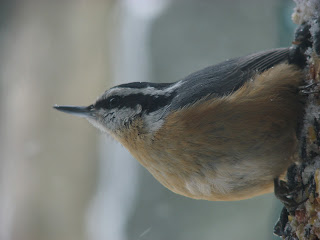Red-bellied Woodpecker
Melanerpes carolinus
This is a medium sized woodpecker but the largest winter woodpecker that is a feeder visitor at Protection Farm. In fact the only larger woodpecker in the area is the Pileated which does not visit the feeder to my knowledge. This may be due to the fact that the Pileated prefer insects such as carpenter ants to seeds and nuts, although they eat seeds and nuts. The Pileated's are here year round, and I expect that there are still plenty of big old trees that have caches of living Carpenter Ants.
I am not sure if we have more than one individual Red-bellied here, but I am thinking that there may be just the this one photographed one visiting the feeders. This one is a male. Males have a complete red cap, females red nape only.
This bird has played hard to get with me. It may be the same bird, but all of last winter and up until the last few days, this bird has played very coy. It likes to hide behind the tree limb that I have hung the feeder on. If I am outside, it flies immediately away. It knows when I am inside the window and watches me with jerking, head around the corner moves.
I have not been able to be near it when I am outside and so my outdoor observations are few. It doesn’t seem to mind the other birds and share the suet feeders with both the Hairy and Downy woodpeckers, and the Chickadees and Nuthatches in what seems to be a very amicable way. They don’t seem to get a long with the Blue-jays and the Red Squirrels, but who does?
I have not been able to be near it when I am outside and so my outdoor observations are few. It doesn’t seem to mind the other birds and share the suet feeders with both the Hairy and Downy woodpeckers, and the Chickadees and Nuthatches in what seems to be a very amicable way. They don’t seem to get a long with the Blue-jays and the Red Squirrels, but who does?
Occasionally it will get comfortable and hop onto the suet feeder. The best part of this is that I have been able to get underbelly shots of the bird, showing its red belly patch. I have been told by other birders that it is rare to get a glimpse of this patch.
Just this past week it has begun really exposing itself to me. Both the Red-bellied and the Hairy have been hopping around on the tree limb, I supposed because they are used to seeing me and feel safer now. Both come into the feeder, land on the very top of the limb perch, and crawl down to the feeder and find a way to get at it. They also prefer to leave the feeder station by climbing to the top of the perch and flying away from that position. This has allowed me to get some great shots of both birds. I had not been able in three years to get a good shot at the back pattern of the Red-belly. Now I have and from tip to toe, front and back, this is a spectacular looking bird. Now maybe I can get to know more about its social patterns.
They breed in deciduous forests of the Eastern U.S. as far south as Florida and the Gulf Coast. They have extended their range to Southern Canada and the Northeastern U.S and can now be found in the Dakotas and Montana, Oklahoma, and Nebraska.
It is tempting to call these woodpeckers “Red-headed” but they are not. Note the belly patch.
Red-bellies are omnivores, eating insects, nuts, fruit, and seeds.
Their prime habitat is deciduous forests and they nest in decayed cavities.
According to the Cornell All About Birds Life History page:
-You may occasionally see a Red-bellied Woodpecker flying quickly and erratically through the forest, abruptly changing direction, alighting for an instant and immediately taking off again, keeping up a quick chatter of calls. Scientists categorize this odd behavior as a type of play that probably helps young birds practice the evasive action they may one day need.
-A Red-bellied Woodpecker can stick out its tongue nearly 2 inches past the end of its beak. The tip is barbed and the bird’s spit is sticky, making it easier to snatch prey from deep crevices. Males have longer, wider-tipped tongues than females, possibly allowing a breeding pair to forage in slightly different places on their territory and maximize their use of available food.
-The oldest known Red-bellied Woodpecker was 12 years 1 month old.
Calls and Sound: http://www.allaboutbirds.org/guide/Red-bellied_Woodpecker/sounds



















































